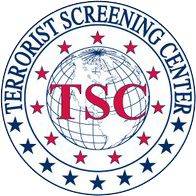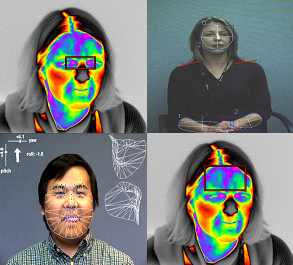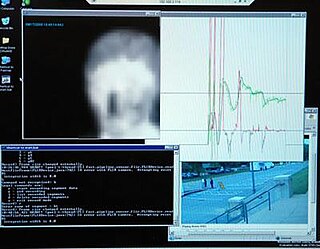Related Research Articles

After the September 11, 2001 attacks, the United States government responded by commencing immediate rescue operations at the World Trade Center site, grounding civilian aircraft, and beginning a long-term response that included official investigations, legislative changes, military action, and restoration projects.

Counterterrorism, also known as anti-terrorism, relates to the practices, military tactics, techniques, and strategies that governments, law enforcement, businesses, and intelligence agencies use to combat or eliminate terrorism.

Airport security includes the techniques and methods used in an attempt to protect passengers, staff, aircraft, and airport property from malicious harm, crime, terrorism, and other threats.
The No Fly List, maintained by the United States federal government's Terrorist Screening Center (TSC), is one of several lists included in algorithmic rulesets used by government agencies and airlines to decide who to allow to board airline flights. The TSC's No Fly List is a list of people who are prohibited from boarding commercial aircraft for travel within, into, or out of the United States. This list has also been used to divert aircraft away from U.S. airspace that do not have start- or end-point destinations within the United States. The number of people on the list rises and falls according to threat and intelligence reporting. There were reportedly 16,000 names on the list in 2011, 21,000 in 2012, and 47,000 in 2013.
Defenses against swimmer incursions are security methods developed to protect watercraft, ports and installations, and other sensitive resources in or near vulnerable waterways from potential threats or intrusions by swimmers or scuba divers.

Port security is part of a broader definition concerning maritime security. It refers to the defense, law and treaty enforcement, and Counterterrorism activities that fall within the port and maritime domain. It includes the protection of the seaports themselves and the protection and inspection of the cargo moving through the ports. Security risks related to ports often focus on either the physical security of the port, or security risks within the maritime supply chain.

The Terrorist Screening Center (TSC) is a division of the National Security Branch of the Federal Bureau of Investigation. It is the duty of the TSC to identify suspected or potential terrorists. Though housed within the FBI, the TSC is a multi-agency organization, including representatives from the United States Department of Justice, the United States Department of State, the United States Department of Homeland Security, the United States Department of Defense, the United States Postal Service, and various private contractors. It is located in Vienna, Virginia, near Virginia State Route 123.
The Terrorist Screening Database (TSDB) is the central terrorist watchlist consolidated by the Federal Bureau of Investigation's Terrorist Screening Center and used by multiple agencies to compile their specific watchlists and for screening. The list was created after the September 11 attacks.

A full-body scanner is a device that detects objects on or inside a person's body for security screening purposes, without physically removing clothes or making physical contact. Unlike metal detectors, full-body scanners can detect non-metal objects, which became an increasing concern after various airliner bombing attempts in the 2000s. Some scanners can also detect swallowed items or items hidden in the body cavities of a person. Starting in 2007, full-body scanners started supplementing metal detectors at airports and train stations in many countries.

Project Hostile Intent is an ongoing project of the United States Department of Homeland Security and Human Factors Division. It has been renamed to Future Attribute Screening Technology. This project comes under the Social and Behavioral Research (SBR) Program, one of the three broad program areas within the Science and Technology (S&T) Directorate of the Department of Homeland Security (DHS) that "sponsors research to inform, develop, and test tools and methodologies to assess terrorist threats, understand terrorism, and improve national security".
BioWatch is a United States federal government program to detect the release of pathogens into the air as part of a terrorist attack on major American cities. Reportedly operating in Philadelphia, New York City, Washington, DC, San Diego, Boston, Chicago, San Francisco, Atlanta, St. Louis, Houston, Los Angeles and 21 other cities, the BioWatch program was created in 2001 in response to the increased threat of bioterrorism sparked by the 2001 anthrax attacks, and was announced in President George W. Bush's State of the Union Address of 2003.

The Northrop Grumman Guardian is a passive anti-missile countermeasure system designed specifically to protect commercial airliners from shoulder-launched missiles, using directed infrared countermeasures (DIRCM) technology.
In the United States, border security includes the protection of ports, airports, and the country's 3,017-mile (4,855 km) land border with Canada and 1,933-mile (3,111 km) border with Mexico.

Future Attribute Screening Technology (FAST) is a program created by the Department of Homeland Security. It was originally titled Project Hostile Intent. The purpose is to detect "Mal Intent" by screening people for "psychological and physiological indicators" in a "Mobile Screening Laboratory".
Magic Lantern is keystroke logging software created by the United States' Federal Bureau of Investigation (FBI). Magic Lantern was first reported in a column by Bob Sullivan of MSNBC on November 20, 2001 and by Ted Bridis of the Associated Press.
The Vigilant Eagle Airport Protection System is a proposed directed-energy weapon under development by the U.S. military under a Defense Department contract with Raytheon. It would create an invisible microwave dome around an airport that could block missiles heading toward incoming and outgoing aircraft.
The attempted bombing of Northwest Airlines Flight 253 occurred on December 25, 2009, aboard an Airbus A330 as it prepared to land at Detroit Metropolitan Airport following a transatlantic flight from Amsterdam. Attributed to the terrorist organization al-Qaeda in the Arabian Peninsula (AQAP), the act was undertaken by 23-year-old Nigerian national Umar Farouk Abdulmutallab using chemical explosives sewn to his underwear. These circumstances, including the date, led to Abdulmutallab being commonly nicknamed either the "Underwear bomber" or "Christmas Day bomber" by American media outlets. It also could have been the worst plane crash in the history of Michigan beating out Northwest Airlines Flight 255.
WeCU Technologies is a technology company based in Israel that is developing a "mind reading" technology. The company's products evaluate reactions to specific images for indications that someone is a potential threat.
A body cavity bomb (BCB) is an explosive device hidden inside the body of a person in order to commit a suicide attack.
Mark G. Frank is a communication professor and department chair, and an internationally recognized expert on human nonverbal communication, emotion, and deception. He conducts research and does training on micro expressions of emotion and of the face. His research studies include other nonverbal indicators of deception throughout the rest of the body. He is the Director of the Communication Science Center research laboratory that is located on the North Campus of the University at Buffalo. Under his guidance, a team of graduate researchers conduct experiments and studies for private and government entities. Frank uses his expertise in communication and psychology to assist law enforcement agencies in monitoring both verbal and nonverbal communication.
References
- ↑ Barrie, Allison (September 23, 2008). "Homeland Security Detects Terrorist Threats by Reading Your Mind". Fox News . Retrieved 2008-09-24.
- ↑ Salem, Mahmoud; Elkaseer, Ahmed; El-Maddah, Islam A. M.; Youssef, Khaled Y.; Scholz, Steffen G.; Mohamed, Hoda K. (January 2022). "Non-Invasive Data Acquisition and IoT Solution for Human Vital Signs Monitoring: Applications, Limitations and Future Prospects". Sensors. 22 (17): 6625. Bibcode:2022Senso..22.6625S. doi: 10.3390/s22176625 . ISSN 1424-8220. PMC 9460364 . PMID 36081081.
- ↑ "New airport screening 'could read minds'". IndianaExpress.com. September 24, 2008. Retrieved 2008-09-24.